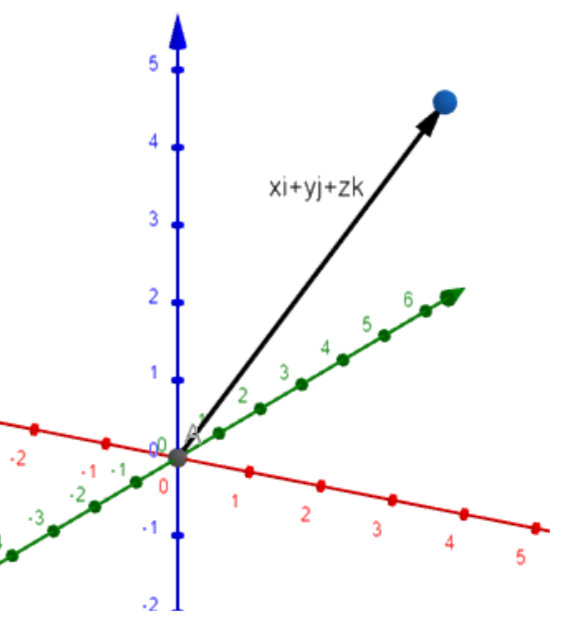
If it is given that vectors $\overrightarrow{a}=x\hat{i}+2\hat{j}-z\hat{k}$ and $\overrightarrow{b}=3\hat{i}-y\hat{j}+\hat{k}$ are two equal vectors, then write the value of x + y + z.
Answer
576.3k+ views
Hint: To solve this question, we will first define what a vector is and its representation in 3D space. Then we will define what are equal vectors. We will apply the condition for equal vectors on the given vectors and try to find the value of x, y, and z. Once we get all the values, we can add them to get x + y + z.
Complete step-by-step solution:
A vector is an entity in 3D space which has magnitude as well as direction. It is used to represent physical phenomena as force, acceleration, velocity, etc. In 3D space, it is represented by a ray.
A figure of a vector in 3D space is as follows:

For two vectors to be equal, they should be equal in magnitude as well as the direction. Hence, the coefficient of $\hat{i}$, $\hat{j}$ and $\hat{k}$ must be equal in two equal vectors.
We are given that vectors $\overrightarrow{a}$ is equal to vector $\overrightarrow{b}$, where $\overrightarrow{a}=x\hat{i}+2\hat{j}-z\hat{k}$ and $\overrightarrow{b}=3\hat{i}-y\hat{j}+\hat{k}$.
$\Rightarrow x\hat{i}+2\hat{j}-z\hat{k}=3\hat{i}-y\hat{j}+\hat{k}$
The coefficient of $\hat{i}$ on the left-hand side is x, whereas on the right-hand side is 3.
$\Rightarrow $ x = 3
The coefficient of $\hat{j}$ on the left-hand side is 2, whereas on the right-hand side is ─y.
$\Rightarrow $ y = ─2
The coefficient of $\hat{z}$ on the left-hand side is ─z, whereas on the right-hand side is 1.
$\Rightarrow $ z = ─1
Therefore, x + y + z = 3 – 2 – 1
Hence, x + y + z = 0.
Note: A vector is generally denoted as $x\hat{i}+y\hat{j}+z\hat{k}$, where x, y, and z are the coordinate of its tip in the 3D space and $\hat{i}$, $\hat{j}$ and $\hat{k}$ are unit vectors in the direction x, y, and z respectively. The magnitude of the vector is $\sqrt{{{x}^{2}}+{{y}^{2}}+{{z}^{2}}}$ and the direction is of the vector is from origin (0, 0, 0) to the tip (x, y, z).
Complete step-by-step solution:
A vector is an entity in 3D space which has magnitude as well as direction. It is used to represent physical phenomena as force, acceleration, velocity, etc. In 3D space, it is represented by a ray.
A figure of a vector in 3D space is as follows:

For two vectors to be equal, they should be equal in magnitude as well as the direction. Hence, the coefficient of $\hat{i}$, $\hat{j}$ and $\hat{k}$ must be equal in two equal vectors.
We are given that vectors $\overrightarrow{a}$ is equal to vector $\overrightarrow{b}$, where $\overrightarrow{a}=x\hat{i}+2\hat{j}-z\hat{k}$ and $\overrightarrow{b}=3\hat{i}-y\hat{j}+\hat{k}$.
$\Rightarrow x\hat{i}+2\hat{j}-z\hat{k}=3\hat{i}-y\hat{j}+\hat{k}$
The coefficient of $\hat{i}$ on the left-hand side is x, whereas on the right-hand side is 3.
$\Rightarrow $ x = 3
The coefficient of $\hat{j}$ on the left-hand side is 2, whereas on the right-hand side is ─y.
$\Rightarrow $ y = ─2
The coefficient of $\hat{z}$ on the left-hand side is ─z, whereas on the right-hand side is 1.
$\Rightarrow $ z = ─1
Therefore, x + y + z = 3 – 2 – 1
Hence, x + y + z = 0.
Note: A vector is generally denoted as $x\hat{i}+y\hat{j}+z\hat{k}$, where x, y, and z are the coordinate of its tip in the 3D space and $\hat{i}$, $\hat{j}$ and $\hat{k}$ are unit vectors in the direction x, y, and z respectively. The magnitude of the vector is $\sqrt{{{x}^{2}}+{{y}^{2}}+{{z}^{2}}}$ and the direction is of the vector is from origin (0, 0, 0) to the tip (x, y, z).
Recently Updated Pages
Master Class 12 Business Studies: Engaging Questions & Answers for Success

Master Class 12 Economics: Engaging Questions & Answers for Success

Master Class 12 English: Engaging Questions & Answers for Success

Master Class 12 Maths: Engaging Questions & Answers for Success

Master Class 12 Social Science: Engaging Questions & Answers for Success

Master Class 12 Chemistry: Engaging Questions & Answers for Success

Trending doubts
What are the major means of transport Explain each class 12 social science CBSE

Which are the Top 10 Largest Countries of the World?

Draw a labelled sketch of the human eye class 12 physics CBSE

How much time does it take to bleed after eating p class 12 biology CBSE

Explain sex determination in humans with line diag class 12 biology CBSE

Differentiate between homogeneous and heterogeneous class 12 chemistry CBSE




